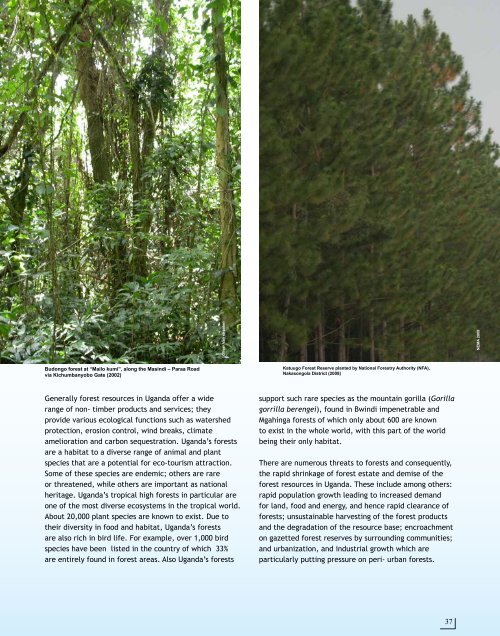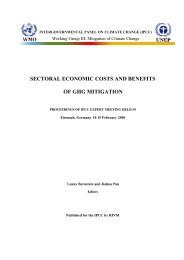The Uganda Atlas - GRID-Arendal
The Uganda Atlas - GRID-Arendal
The Uganda Atlas - GRID-Arendal
You also want an ePaper? Increase the reach of your titles
YUMPU automatically turns print PDFs into web optimized ePapers that Google loves.
Oliver Van straaten<br />
NEMA 2009<br />
Budongo forest at “Mailo kumi”, along the Masindi – Paraa Road<br />
via Kichumbanyobo Gate (2002)<br />
Katuugo Forest Reserve planted by National Forestry Authority (NFA),<br />
Nakasongola District (2008)<br />
Generally forest resources in <strong>Uganda</strong> offer a wide<br />
range of non- timber products and services; they<br />
provide various ecological functions such as watershed<br />
protection, erosion control, wind breaks, climate<br />
amelioration and carbon sequestration. <strong>Uganda</strong>’s forests<br />
are a habitat to a diverse range of animal and plant<br />
species that are a potential for eco-tourism attraction.<br />
Some of these species are endemic; others are rare<br />
or threatened, while others are important as national<br />
heritage. <strong>Uganda</strong>’s tropical high forests in particular are<br />
one of the most diverse ecosystems in the tropical world.<br />
About 20,000 plant species are known to exist. Due to<br />
their diversity in food and habitat, <strong>Uganda</strong>’s forests<br />
are also rich in bird life. For example, over 1,000 bird<br />
species have been listed in the country of which 33%<br />
are entirely found in forest areas. Also <strong>Uganda</strong>’s forests<br />
support such rare species as the mountain gorilla (Gorilla<br />
gorrilla berengei), found in Bwindi impenetrable and<br />
Mgahinga forests of which only about 600 are known<br />
to exist in the whole world, with this part of the world<br />
being their only habitat.<br />
<strong>The</strong>re are numerous threats to forests and consequently,<br />
the rapid shrinkage of forest estate and demise of the<br />
forest resources in <strong>Uganda</strong>. <strong>The</strong>se include among others:<br />
rapid population growth leading to increased demand<br />
for land, food and energy, and hence rapid clearance of<br />
forests; unsustainable harvesting of the forest products<br />
and the degradation of the resource base; encroachment<br />
on gazetted forest reserves by surrounding communities;<br />
and urbanization, and industrial growth which are<br />
particularly putting pressure on peri- urban forests.<br />
37

















